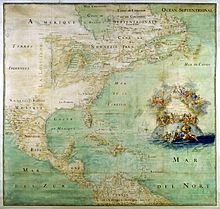新法蘭西
| 新法蘭西副王區 Viceroyauté de Nouvelle France | |||||||||||||||||
|---|---|---|---|---|---|---|---|---|---|---|---|---|---|---|---|---|---|
| 1534年—1763年 | |||||||||||||||||
 新法蘭西在1721年在北美洲的疆域 | |||||||||||||||||
| 地位 | 法國殖民地 | ||||||||||||||||
| 首都 | 魁北克市 | ||||||||||||||||
| 常用語言 | 加拿大法語 | ||||||||||||||||
| 宗教 | 羅馬天主教 | ||||||||||||||||
| 政府 | 君主制 | ||||||||||||||||
| 法蘭西國王 | |||||||||||||||||
| 副王 | |||||||||||||||||
| 立法機構 | 新法蘭西主權委員會 | ||||||||||||||||
| 歷史 | |||||||||||||||||
• 建立 | 1534年 | ||||||||||||||||
| 1759年 | |||||||||||||||||
| 1760年 | |||||||||||||||||
| 1763年2月10日 | |||||||||||||||||
| 面積 | |||||||||||||||||
| 1750 | 8,000,000平方公里 | ||||||||||||||||
| 人口 | |||||||||||||||||
• 1750 | 90,000 | ||||||||||||||||
| 貨幣 | 新法蘭西里弗爾 | ||||||||||||||||
| |||||||||||||||||
| 系列條目 |
| 加拿大歷史 |
|---|
 |
| 年表 |
| 專題史 |
|
|
新法蘭西(法語:Nouvelle-France;英語:New France),法國位於北美洲的殖民地。北起哈德遜灣,南至墨西哥灣,包含聖羅倫斯河及密西西比河流域,劃分成加拿大、阿卡迪亞、紐芬蘭島、路易斯安那四個區域。[5]

1524年,義大利航海家維拉薩諾探索了北美洲東岸並為新土地命名為法蘭西斯科,以紀念法國國王法蘭索瓦一世。但是,法國大部分人最初對這裡未感興趣。然而,法國漁船繼續航行當地;而法國客商亦很快體會聖羅倫斯地區有大量可貴的毛皮,特別是海狸的毛皮在歐洲十分罕見。最終,法國人決定在此地拓殖,以擴展其在美洲的影響力。
為了保持毛皮貿易,法國人薩繆爾·德·尚普蘭與當地的阿貢昆人和Montagnais人合作,對抗由其他原住民族組成的易洛魁聯盟。他亦準備送年輕的法國人與當地人生活,學習他們的語言和風俗,以幫助法國人適應在北美洲的生活。這些人擴大了法國對南部和西部的影響。
當時南部的英國十三殖民地人口眾多,而且十分富裕。路易十三的主要大臣黎塞留希望可以讓新法蘭西像英國殖民地一樣富裕。他在新法蘭西投資,任命尚普蘭為新法蘭西的總督。
之後,路易十四也禁止了非羅馬天主教徒居住在新法蘭西,使許多人改住在英國殖民地。
至18世紀中葉,法國定居點仍然發展較好。人口大約70000人,主要是靠自然增長。[6][7]在法國統治下的歐洲人人口增長緩慢。[8][9][10]南部沿著大西洋海岸的十三殖民地人口不斷增長,並且有更多來自歐洲的移民。至1760年代,約有160萬人居住在英國殖民地。人口與新法蘭西相比是23比1。1763年七年戰爭結束後,英國接管了新法蘭西北部地區,1867年這些地區被併入加拿大,法國於1803年將路易斯安那領地出售給美國,使美國的領土面積擴大了一倍。
目前,在前新法蘭西的領土中,只剩下聖皮埃爾和密克隆仍然由法國控制。

參見
[編輯]參考資料
[編輯]- ^ New York State Historical Association. Proceedings of the New York State Historical Association with the Quarterly Journal: 2nd-21st Annual Meeting with a List of New Members. The Association. 1915 [2021-03-05]. (原始內容存檔於2021-03-23).
It is most probable that the Bourbon Flag was used during the greater part of the occupancy of the French in the region extending southwest from the St. Lawrence to the Mississippi , known as New France... The French flag was probably blue at that time with three golden fleur - de - lis ....
- ^ Background: The First National Flags. The Canadian Encyclopedia. 28 November 2019 [1 March 2021]. (原始內容存檔於2021-03-23).
At the time of New France (1534 to the 1760s), two flags could be viewed as having national status. The first was the banner of France — a blue square flag bearing three gold fleurs-de-lys. It was flown above fortifications in the early years of the colony. For instance, it was flown above the lodgings of Pierre Du Gua de Monts at Île Sainte-Croix in 1604. There is some evidence that the banner also flew above Samuel de Champlain’s habitation in 1608. ..... the completely white flag of the French Royal Navy was flown from ships, forts and sometimes at land-claiming ceremonies.
- ^ INQUINTE.CA | CANADA 150 Years of History ~ The story behind the flag. inquinte.ca. [2021-03-05]. (原始內容存檔於2021-03-23).
When Canada was settled as part of France and dubbed "New France," two flags gained national status. One was the Royal Banner of France. This featured a blue background with three gold fleurs-de-lis. A white flag of the French Royal Navy was also flown from ships and forts and sometimes flown at land-claiming ceremonies.
- ^ Wallace, W. Stewart. Flag of New France. The Canadian Encyclopedia II. Toronto: University Associates of Canada: 350–351. 1948.
During the French régime in Canada, there does not appear to have been any French national flag in the modern sense of the term. The "Banner of France", which was composed of fleur-de-lys on a blue field, came nearest to being a national flag, since it was carried before the king when he marched to battle, and thus in some sense symbolized the kingdom of France. During the later period of French rule, it would seem that the emblem...was a flag showing the fleur-de-lys on a white ground.... as seen in Florida. There were, however, 68 flags authorized for various services by Louis XIV in 1661; and a number of these were doubtless used in New France
- ^ R. Douglas Francis; Richard Jones; Donald B. Smith. Journeys: A History of Canada. Cengage Learning. 2009: 51 [2016-06-02]. ISBN 0-17-644244-8. (原始內容存檔於2021-03-23).
- ^ Estimated population of Canada, 1605 to present. Statistics Canada. 2009 [August 26, 2010]. (原始內容存檔於2018-12-24).
- ^ David L. Preston. The Texture of Contact: European and Indian Settler Communities on the Frontiers of Iroquoia, 1667–1783. U of Nebraska Press. 2009: 43 [2017-10-21]. ISBN 978-0-8032-2549-7. (原始內容存檔於2021-03-23).
- ^ John Powell. Encyclopedia of North American Immigration. Infobase Publishing. 2009: 203 [2017-10-21]. ISBN 978-1-4381-1012-7. (原始內容存檔於2021-03-23).
- ^ Ronald J. Dale. The Fall of New France: How the French Lost a North American Empire 1754–1763. James Lorimer & Company. 2004: 2 [2017-10-21]. ISBN 978-1-55028-840-7. (原始內容存檔於2021-03-23).
- ^ John E. Findling; Frank W. Thackeray. What Happened?: An Encyclopedia of Events that Changed America Forever. ABC-CLIO. 2011: 38 [2017-10-21]. ISBN 978-1-59884-621-8. (原始內容存檔於2021-03-23).
| ||||||||||||||||||||||||||||||||||||||||||||||||||||||||||

![新法蘭西上:法蘭西王國旗幟 下:法蘭西皇家旗幟[1][2][3][4]](http://upload.wikimedia.org/wikipedia/commons/thumb/8/82/Royal_flag_of_France.svg/125px-Royal_flag_of_France.svg.png)

